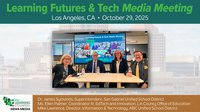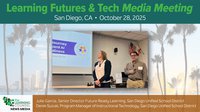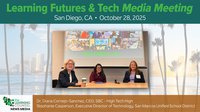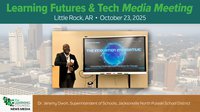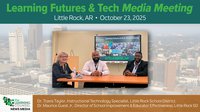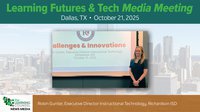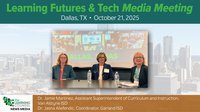Editor’s note: This is the latest in a monthly series on the impact of Affective Leadership in the school system. Affective leadership is all about working with people, rather than trying to work through them or simply going around them. All stakeholders become far more invested in the school, when they feel genuinely valued, respected, and heard by administration. The pandemic has immeasurably heightened this need for connectivity.
Educators have unquestionably faced a litany of unprecedented challenges this school year. All administrators and staff members should be highly commended for all their efforts to provide students a safe and productive learning environment in the midst of these most challenging times.
With the calendar changing and the mid-point of the school year fast approaching, now is an ideal opportunity to reassess the new educational landscape moving forward. Much of the fear and anxiety that was understandably prevalent last August, has now given way to a much more informed perspective on how schools should proceed for the duration of this academic year and beyond.
The many changes to school and classroom life this fall were born of necessity, as the status quo was simply not going to sufficiently address the safety concerns of staff, parents, and students. Most of these required changes have had their intended short-term impact, but others clearly have the potential to trigger long-term improvements to various aspects of school life.
Now is the time for principals and their staffs to begin to discuss, and plan for, which COVID-triggered responses should become permanent. Principals need to lead these discussions about what will be the key positive aspects of the pandemic’s educational legacy.
Better Overall Communication
The fall has been full of information and misinformation regarding the pandemic in general, and the impact on schools specifically. Many educators were understandably anxious about physically returning to school, while others were equally nervous about the logistics of virtual learning or some related hybrid model. Everyone was also dealing with a long list of unknowns that were changing on a seemingly daily basis.
Even though the conventional means of conversation were either eliminated or significantly altered, principals have kept all stakeholders well informed of any important new information and/or additional required changes to protocols. It has also been imperative for school leaders to consistently convey a proper balance of optimism and caution in their messaging. The timeliness and tone of office communication in future years will undoubtedly benefit from the imposed parameters of the pandemic.
Increased Access to Technology
Throughout the pandemic, there has been considerable debate on the relative merit of in-class vs. virtual learning. While the ultimate post-pandemic goal is obviously to get all students physically back in class, the increased dependence on technology has certainly laid the groundwork for some potential long-term benefits: students and teachers both feel more comfortable with a wider range of school-based technology, it allows students to learn more at their own pace, students have more opportunities to verbally explain their own thinking, and they have a stronger voice in their overall learning.
The other key issue regarding technology that has risen to the forefront during the pandemic relates to student access. The whole remote learning debate has highlighted the glaring disparity in home technology, both in terms of available devices and Internet access. These disparities were exposed across given classrooms, schools and districts. Hopefully the pandemic will play a key role in mobilizing the necessary political will to begin leveling the playing field in technology availability for all students across all school districts. Far too many students have not had the opportunity to “be all in this together” when it comes to technology.
Greater Professional Autonomy
Principals have been confronted with many previously unseen issues, thus far this school year. As such, their time management balance has had to shift significantly, and they may well not have had the time to monitor daily academic programming as they normally would. Safety concerns have greatly reduced their in-person interactions with staff and students, as well as the opportunities for professional dialogue. The combination of some students learning in-class and others learning virtually has also made things far more challenging to track.
The result has been that teachers have enjoyed unprecedented professional autonomy in many respects this fall, as there is literally no one looking over their shoulders. People have had to rise to the occasion more from their own volition, and this will hopefully help lay the foundation for stronger levels of professional trust among administration and all staff members moving forward.
Stronger Connection with Parents
The pandemic has necessitated that the home school partnership evolved from one of basic cooperation to one of true collaboration. Instead of parents and school staff simply doing their best to be polite and courteous to one another, this unprecedented situation has demanded a real team effort. All parties have had to prioritize safety for all in and around the school building, and accomplishing this goal has required everyone’s unwavering commitment. One weak link would have significantly compromised the strength of the overall chain.
Historically, far too many interactions between home and school have been some kind of zero-sum game, whereas throughout the pandemic everyone has truly been on the same team – team safety. Many teachers are in fact parents themselves, and they can very much relate to safety concerns parents and/or students have had this fall. By the same token, parents have been better able to appreciate the concerns and stresses that staff members have confronted at both home and school. The pandemic has inadvertently laid the groundwork for a heightened degree of empathy among staff members and parents, as many of the reasons for typical school-family disconnects would have seemed awfully trivial this fall.
Deeper Sense of Resilience
The many stressors and uncertainties associated with return to school plans this past fall required everyone involved to emotionally toughen up and make the best of an extremely daunting situation. Staff and students physically at school, as well as students learning from home, have all had to courageously charter totally unknown terrain.
Resilience can never be meaningfully taught in isolated lessons, and its key strategies continue to be embedded throughout the entire teaching and learning experience. Most powerfully, teachers, parents, and administrators have collectively conveyed a strong sense of resilience, which has provided wonderful role modelling for students of all ages. The resilience both required, and developed, by all parties during this unprecedented time will give them the confidence and intestinal fortitude to successfully confront major life challenges and surprises in the ensuing years.
About the Author
Jamie Bricker is a published author and international speaker. As a retired school principal, he has long been a strong advocate of affective leadership and has experienced its profound impact. He is also co-host of two podcasts, including Affective Leadership – Positivity Promotes Productivity. He also blogs weekly on various aspects of affective leadership, and his blogs can be found on LinkedIn. Jamie can be contacted by email at info@jamiebricker.com or through his website at www.jamiebricker.com.




